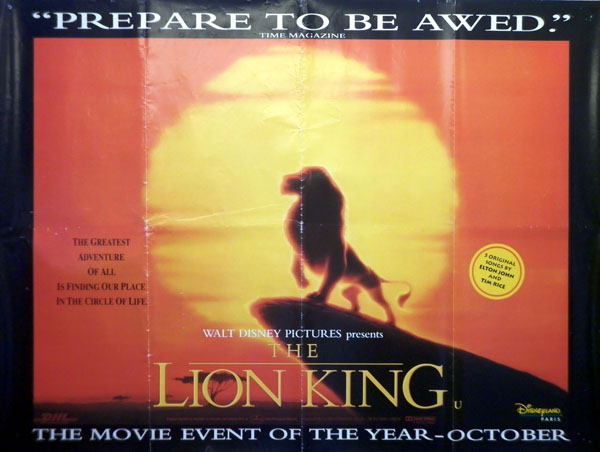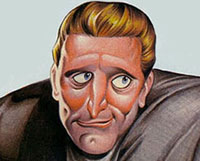
Hahn on The Lion King. In 1994, producer Don Hahn talked to reporter Ryan A. Harmon about the animated feature film The Lion King (1994), “As human beings, we feel a link to lions. Because of their regal king of the beasts quality, they seemed like the logical royal family for our story. Its about the day when the mantle of responsibility is passed to us from our parents that day when you have to grow up. Its very touching in that way because we call all relate to that.”
 “The Lion King is an emotional, dramatic piece — but its also drop-dead funny! As filmmakers and artists, were always pushing ourselves in completely new directions. The Lion King attracted our interests because it was an opportunity to do a completely non-human, allegorical story about a father and son, in a terrific new setting. I think The Lion King takes you someplace youve never been before.”
“The Lion King is an emotional, dramatic piece — but its also drop-dead funny! As filmmakers and artists, were always pushing ourselves in completely new directions. The Lion King attracted our interests because it was an opportunity to do a completely non-human, allegorical story about a father and son, in a terrific new setting. I think The Lion King takes you someplace youve never been before.”
“Elton John is a great fan of animation and loved the story. He rarely works with other lyricists but he and Tim Rice became a song writing team and wrote five amazing tunes for the film. You would probably never see Jeremy Irons and James Earl Jones cast as brothers in a live-action film but because this is animation, you can get that great eclectic mix and its really effective.”
 Hormones for Aladdin. From the New York Times November 8, 1992, animator Glen Keane discussed the challenges he faced animating the character of Aladdin in Disney’s Aladdin (1992) since the story changed completely at least three times. Jasmine’s so charismatic, said Jeffrey Katzenberg, she just put this guy away; he was like a milquetoast. Keane kept losing touch with the emotions driving Aladdin until he hit on the idea of Tom Cruise. In Top Gun, Tom Cruise carried himself with a kind of confidence and an air of invincibility, said Keane. All of our men have tended to be princely, but soft and delicate like the prince in Sleeping Beauty. With Aladdin, weve given the male lead more of a masculine quality.
Hormones for Aladdin. From the New York Times November 8, 1992, animator Glen Keane discussed the challenges he faced animating the character of Aladdin in Disney’s Aladdin (1992) since the story changed completely at least three times. Jasmine’s so charismatic, said Jeffrey Katzenberg, she just put this guy away; he was like a milquetoast. Keane kept losing touch with the emotions driving Aladdin until he hit on the idea of Tom Cruise. In Top Gun, Tom Cruise carried himself with a kind of confidence and an air of invincibility, said Keane. All of our men have tended to be princely, but soft and delicate like the prince in Sleeping Beauty. With Aladdin, weve given the male lead more of a masculine quality.

Kirk – by John K. and Bruce Timm
“It doesnt mean a garbage dump of creativity. Thats what we have right now. I’m really only rebellious in this day because were living in such a bland, cultureless age. So Im not doing anything weirder than what they would have done in the 1940s. I have to rebel just to get the standards back to what they used to be, just to put animation back on track and make it an art form”.
The Rosey and Buddy Show. In the Boston Globe, May 15, 1992, actor Tom Arnold talked about the prime time comedy special The Rosey and Buddy Show: “Rosey (Rosanne Barr Arnold) and I had a Saturday morning cartoon show called Little Rosey based on our real family. ABC wanted to change it. They wanted an older boy, maybe two or three boys, because they wanted to sell more toys.”
“We didnt want to change our family, so we parted company. For prime time, we made the kids a little older and we added a lot of satireparodies of commecials, other TV shows, other cartoons.” The storyline has the family go to Cartoon Land to fight the evil powers that be like the “network executives who are weasels” who want the show to be “beautiful, inspiring and, not to mention, profitable”.
 Charles Schulz Talks Animation. In an interview with comics historian Rick Marshall published in Nemo magazine #31, cartoonist Charles Schulz talked about the early movies featuring his Peanuts characters: “(A Boy Named Charlie Brown 1969) was the first movie. We were victims of making the movie too long. I think it did have a few good parts and it was very successful, but it was just too long and it stretched out. I dont think any of the movies hold up except Snoopy Come Home (1972).”
Charles Schulz Talks Animation. In an interview with comics historian Rick Marshall published in Nemo magazine #31, cartoonist Charles Schulz talked about the early movies featuring his Peanuts characters: “(A Boy Named Charlie Brown 1969) was the first movie. We were victims of making the movie too long. I think it did have a few good parts and it was very successful, but it was just too long and it stretched out. I dont think any of the movies hold up except Snoopy Come Home (1972).”
“That one I think is going to last for a long time. It has a lot of funny things in it. Thats a difficult medium. There are so many other people involved. Sometimes I wish I were like Walt Disney and have my own big studio and be there every day and listen to the musicians and watch whats being done and have story conferences. But I have to sit and draw this strip every day. You cant do everything.”
 Secret Origin of All Dogs Go to Heaven. One of the projects Don Bluth was developing after the release of The Secret of NIMH (1982) was a film consisting of three short stories. One story was meant to be a satire of detective films with a mangy German shepherd as a private eye. The dog was designed specifically for actor Burt Reynolds to do the voice. They hoped to leverage their working relationship with actor Dom DeLuise who was his good friend to interest Reynolds.
Secret Origin of All Dogs Go to Heaven. One of the projects Don Bluth was developing after the release of The Secret of NIMH (1982) was a film consisting of three short stories. One story was meant to be a satire of detective films with a mangy German shepherd as a private eye. The dog was designed specifically for actor Burt Reynolds to do the voice. They hoped to leverage their working relationship with actor Dom DeLuise who was his good friend to interest Reynolds.
The Bluth studio even adopted a stray shepherd mix that they named Burt. In 1988, Bluth decided to revive the idea of the dog story with Burt Reynolds and called it All Dogs Go to Heaven, based on the title of a book that a teacher had read to Bluths fourth grade class. The title seemed to either upset or amuse people so some suggested changing the title to “Charlie, the Heavenly Dog”.
“Many people suggested changing the title,” said Bluth. “I thought, ‘No, no, no.’ All Dogs Go to Heaven is very provocative. When I would mention that title to people they would grin. Whether or not you believe in Heaven or an afterlife, it’s still just a little fairy tale, an allegory which says, ‘If you’re ever going to come of age, you have to earn it.’
“All great stories seem to me to have two things in common. They entertain and they educate. I’ve always loved the experience of being carried away in fantasy, but I think it’s important to learn something while you’re there.”


 Jim Korkis is an internationally respected animation historian who in recent years has devoted his attention to the many worlds of Disney. He was a columnist for a variety of animation magazines. With his former writing partner, John Cawley, he authored several animation related books including The Encyclopedia of Cartoon Superstars, How to Create Animation, Cartoon Confidential and Get Animated’s Animation Art Buyer’s Guide. He taught animation classes at the Disney Institute in Florida as well as instructing classes on acting and animation history for Disney Feature Animation: Florida.
Jim Korkis is an internationally respected animation historian who in recent years has devoted his attention to the many worlds of Disney. He was a columnist for a variety of animation magazines. With his former writing partner, John Cawley, he authored several animation related books including The Encyclopedia of Cartoon Superstars, How to Create Animation, Cartoon Confidential and Get Animated’s Animation Art Buyer’s Guide. He taught animation classes at the Disney Institute in Florida as well as instructing classes on acting and animation history for Disney Feature Animation: Florida.




















































Actually I loved the first two Peanuts movies A Boy Named Charlie Brown and Snoopy Come Home. On ABNCB in the scene where Snoopy while looking for Linus’ “lost” blanket in New Your City discovering the ice rink at Rockefeller Center a beautifully orchestrated version of Skating was preformed including a fantastic jazz riff in the middle of the scene showing the transition of Snoopy from figure skater to hockey player (and that was during the time helmets weren’t mandatory in ice hockey!),
And in Snoopy Come Home with a fantastic score by the Sherman Brothers including a song called At The Beach which was later used in Captain Kangaroo about a short film where people were enjoying the beach.
Sadly the third Peanuts movie Race For Your Live Charlie Brown (which many considered as one of the worst Peanuts movies that came out during that time) with a very weak plot line
And the fourth and final Peanuts movies that came out Bon Voyage Charlie Brown (And Don’t Como Back!) had its moments including having the first adult ever shown in Peanuts and Peppermint Patty bringing the term “Ugly American” to a level with her attitude.
And that animated film brought out a tv special What We Have Learned Charlie Brown where Charlie Brown, Linus,Snoopy,Woodstock,Marcie and Peppermint Patty returns to France to visit the war monuments of WWI and WWII including Flanders Field..
I’m sure by the fourth film they were really running out of steam with these theatrical releases.
I do believe Charles Schulz turned down a tryout with Walt Disney Studios not long after starting the “Li’l Folks” strip.
Actually, directly translated, the Latin word “Renaissance” means “rebirth,” such as a rebirth of ideas from the Golden Age of Animation would be an Animation Renaissance.
Sparky nailed it – A Boy Named Charlie Brown is basically a 30 minute TV special with almost an hour of padding.